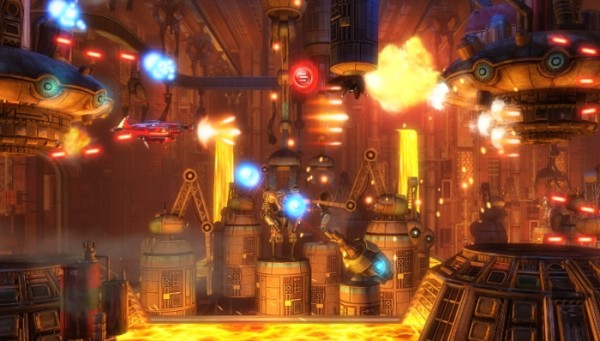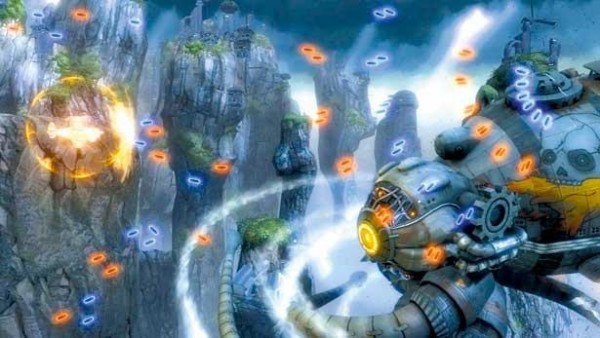The developer/player relationship often moves in one direction – the developer delivers a product, the player experiences it, and the two parties move on. Every so often, though, the developer asks the player to go above and beyond those boundaries in order to attain a greater appreciation of the product.
Just take a look at this year’s Journey, a game in which narrative and meaning were entirely dictated by the player’s own thoughts and ideas on the mysterious world and cryptic artwork. A similar demand of the player is found in Sine Mora, a technically proficient shoot ’em up (shmup) from the folks at Digital Reality and Grasshopper Manufacture. Whereas Journey exemplified the strengths of significant player demands, Sine Mora falters in that same area. Its heavy reliance on the player to add value to the experience only hinders a game that already falls under a niche genre.
What Sine Mora does within the confines of the genre opens up discussion on the game’s redeeming qualities. Time acts as a unique mechanical hook throughout the campaign and replaces the standard health system found in most other shmups. Instead, each section of a level has a time attached to it – the player’s only goal is to reach the end of the section before that timer reaches zero. Players can slow down time for a short while with the help of a special ability, but the task is easier said than done, considering the onslaught of enemies that fill the screen. The tension of working against a time limit and not dying as a result of enemy attacks creates an interesting twist for the genre. The only misstep comes in the form of environmental hazards that result in instant death. It immediately undercuts the time mechanic and leads to needless frustrations.
Frustration may also come as a result of the boss battles, but the thrill of victory trumps any negative emotions. These multi-part battles feature deviously placed missiles, devastating laser attacks, and a myriad of other ridiculously punishing obstacles that stand in the player’s way. The inclusion of such difficulties makes the sense of triumph that much more satisfying – I like to refer to it as the Super Meat Boy effect. The boss battles also show off the game’s crystal clear visuals and impressive production values, including the use of sweeping camera angles to fully demonstrate the size and scope of the mechanical monstrosities. I’m not one to focus too much on visuals, but Sine Mora is clearly one of the best-looking titles on the Vita.
Though the shmup genre usually concerns itself entirely with mechanics, Sine Mora also takes a narrative risk with its tale of revenge and ethnic cleansing. Mature themes and complex characters are explored throughout the game, and the ambitious story both fails and succeeds. On one hand, the narrative comes off as a convoluted mess that can often be impossible to follow, but on the other hand, certain moments are emotionally resonating and help create a drive to make it to that next stage and learn the fate of the characters.
Just as the narrative jumps from one character to the next, the player jumps from one ship to the next. This means the use of various special weapons, from charged single attacks to series of missiles directed at enemies. The main gun gets most of the attention, though, and this leads to yet another unique mechanic on the part of Sine Mora. Included in the many onscreen items are upgrades that increase the power of the main gun. Each time the player takes a hit, that upgrade is lost, but can be picked up again from where it floats on screen. It formulates a risk/reward dynamic in which the risk of picking up a lost upgrade can result in more damage and even more upgrades being lost.
All of these individual elements sound appealing, but they don’t factor into the game’s most crippling issue: value. I often hate the dollar to hour ratio discussion when it comes to video games because it completely discredits the value of an overall experience, but a release like Sine Mora reminds me that sometimes such factors are worth noting. The main campaign is very short – roughly 90 minutes to be more precise, and that’s including the many dialogue sequences. Beyond that are some score attack modes and leaderboards to climb, but it’s a bare-bones offering for anyone other than a hardcore fan of the shmup genre. It’s not merely the fact that Sine Mora is short, because I love plenty of short games. It ties back to the aforementioned developer/player relationship: Digital Reality and Grasshopper Manufacture expect the player to hone their craft, attempt speedruns, and try for the best leaderboard scores, but where does that leave someone who’s only mildly interested in the genre?
The issue of player alienation is a real shame, because Sine Mora takes many risks that pay off. From the admirably mature storyline to the time mechanic, this release attempts to separate itself from the crowd. Even as someone whose skills in the genre are admittedly mediocre, I had quite a bit of fun playing the game. But after a while I was left with that feeling of “now what?” The severe lack of content for someone like me, and in turn many gamers, cannot be ignored no matter how much I’d like to. There are likely hardcore fans of the genre who will love Sine Mora, but I have a hard time calling a game great when it targets such a limited audience.




















